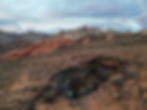Where Fire Once Flowed: Hiking the Lava Tubes Trail in Snow Canyon
- Dan Wagner
- Sep 30
- 3 min read
Hiking the Lava Tubes Trail in Snow Canyon State Park is like stepping into a hidden world carved by fire and time. The trail winds through rugged black basalt and twisted lava formations, leading to a series of fascinating lava tubes—natural tunnels formed thousands of years ago when molten lava cooled on the outside while flowing freely inside. The path is relatively short, making it a favorite for families and casual hikers, yet its otherworldly scenery makes it feel like an adventure far from everyday life. It’s no wonder this trail is considered one of the top hikes in the park, offering a rare glimpse into the park’s fiery geologic history while immersing visitors in a striking desert environment full of breathtaking views.

Hiking the Lava Tubes Trail
Dad and I are back in St. George for one last night when I decide to head into Snow Canyon State Park to hike the Lava Tubes Trail. The storm has passed, the desert air feels crisp, and the sky hints that sunset might be a good one. I enter through the north entrance and make the short drive to the Lava Flow Trailhead. The lot, often full, still has a few open spots, and I manage to slip into one. The trail begins over rough black basalt, remnants of volcanic activity that shaped this place thousands of years ago.

Yucca, cactus, and ephedra punctuate the otherwise stark landscape, while the lava field itself dates back some 20,000 years to the Last Glacial Maximum. The flow is thought to have originated from Cinder Cone, an extinct volcano just a few miles north of the park entrance.

The first lava tube appears around 0.4 miles in, a wide opening created when molten rock cooled on the surface while hot lava continued to flow below. Once the lava drained, the hollow tube remained, and over time parts of the roof collapsed, leaving today’s entrance. I climb down carefully, pausing at a four-foot drop that takes a little maneuvering to get past. At the bottom, I find a small side passage that ends quickly but is still fun to poke around in—though anyone uncomfortable with tight spaces might think twice.

Back on the surface, I pass the second tube, little more than a shallow hole, before continuing on toward the third.

As I press on, the sun arcs toward the horizon, unveiling a beautiful scene. The Navajo sandstone cliffs of the main canyon, freed from the glare of midday light, glow with rich, vibrant hues that stand in striking contrast to the deep black of the ancient lava flow.

At about 1.2 miles, the largest tube comes into view—an impressive cavity nearly 80 feet long, 50 feet wide, and at least 30 feet deep.

I climb in, following a worn path down and switch on my headlamp to explore.

The left side opens just enough to keep going, and after a short scramble I find myself deep inside before the passage finally ends.

Back at the tube's entrance, tiny bats fly into the dimming evening as twilight drapes the landscape. I pause on a mound of lava rock, watching the final light slip across the cliffs. It’s been a stunning evening, and tonight’s sunset feels like the perfect ending.

The trail continues farther west toward sandstone formations, but for me, the lava tubes are the destination. The hike back in the dark takes a little more focus on the uneven ground, but I soon reach the trailhead. What sticks with me most isn’t just the hike itself, but the sense of how much history is preserved in Snow Canyon's rugged landscape—evidence of fire and geologic change that feels both ancient and immediate. It's an excellent hike, one I'd call a must-do in the park, and one I know I'll be coming back to before too long.
_edited.png)





























